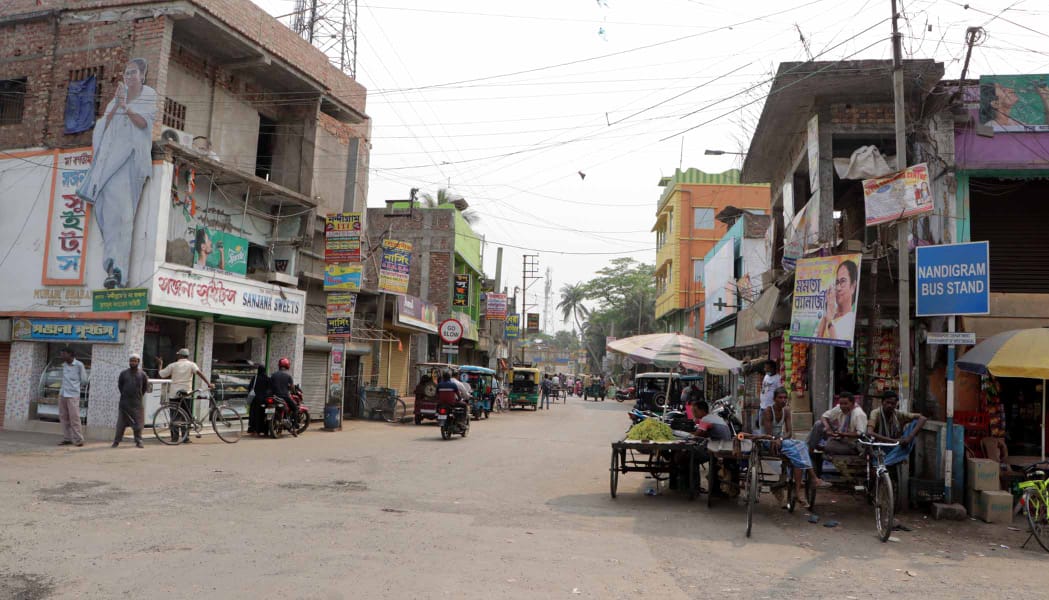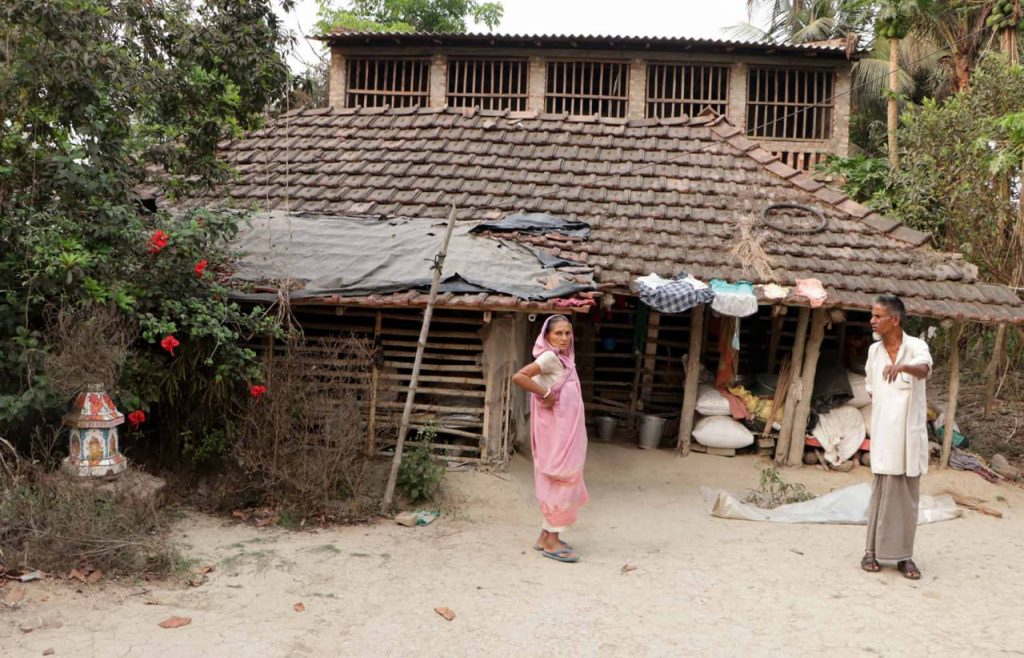
Nandigram’s unity on test as BJP banks on polarisation to vanquish Mamata

Nandigram is once again the epicentre of Bengal politics, 14 years after it shaped the state’s political future with an anti-land acquisition movement.
In 2007, people here – both Hindus and Muslims – shed blood to protect their farm land from being acquired by the then CPI(M)-led Left Front government for a chemical hub.
This unity will be put to test when the constituency goes to polls on Thursday (April 1) as the BJP is blatantly trying to polarise the electorates on religious lines.
A life-size cut-out of Trinammol Congress supremo Mamata Banerjee with folded hands greets visitors to the high-profiled constituency at the main market junction near the bus stand where the road bifurcates. The worn-out asphalted road on the right leads to Hindu-dominated Nandigram block II. To the left is Nandigram block I that has around 35 per cent Muslim population.
The BJP is hoping to get a decisive lead in block II while the TMC is expecting to retain its hold on block I with the backing of minority votes.
Both the blocks are swamped with poll buntings of two main contenders – Chief Minister Mamata Banerjee of the Trinamool Congress and her former confidante Suvendu Adhikari of the BJP.
Adhikari, who was a regular in local iftar parties not too long ago, claims that in Nandigram the contest is between 65 per cent and 35 per cent, alluding to the demographic profile of the constituency. Nandigram has 34.04 per cent Muslim population as per 2011 census.
Related news: Bengal drama gets murkier with BJP-TMC’s leaked clips war
Adhikari these days refers to his opponent Mamata Banerjee as “Begum”, an honorific for a Muslim woman, but used here as a sarcastic dig.
“If Begum wins here, people won’t be able to put a tilak on their forehead, wear tulsi beads around their necks,” Ahikari said at a rally in Nandigram, amidst loud cheers from his supporters.
Sharing a smoke with his friend Jahangir outside his house at the constituency’s Kalicharanpur area, Dipu Singhota expressed serious concern about such rhetoric.
“This is a very dangerous game they are playing. After elections they (political leaders) will go away, never to show their face again. But we have to live here with our neighbours,” he said.
A few yards from them two middle-aged women Alo Gol and Riza Begum were busy in household talks, unfazed by the attempts of the political parties to drive a wedge between them. The two women are next-door neighbours.
Dipu said it was unfortunate that Adhikari, who used to take part in iftar as enthusiastically as in any other Hindu festival, is now making such a divisive statement.
Mamata’s counter to BJP’s Hindutva rhetoric is temple hopping and chanting of Sanskrit mantras at her rallies – an attempt to projecting herself as a “good and true Hindu.”
“Hinduism teaches us to love and respect all. That is what Swami Vivekananda taught us. Who are they (BJP leaders) to give us lessons on Hinduism,” she said at a rally.
There are many Hindus in Nandigram who are not convinced by her assertion.
“She will surely face defeat this time because of her penchant for Muslim appeasement. She has opted to contest from Nandigram only because it has a sizeable Muslim population. But this time, Hindu votes will consolidate against her,” said a local BJP functionary Palash Mandal.
Even TMC leader Abu Taher admits religious polarisation is a matter of concern, adding it’s a new phenomenon in Nandigram.
“If the Nandigram movement was a showpiece of our unity, this electoral battle is all about division,” said Abdul Daiyan Khan, president of the Shahid Smriti Raksha Samiti (SSRS), an organisation of families of “martyrs” of the land-protection movement.

A TMC gram panchayat member Manoranjan Manna said the polarisation was the only hope for the BJP in the constituencies having significant minority population.
“Given the BJP’s attitude towards minorities, Muslims are unlikely to vote for the party. Of Nandigram’s 2,97,299 electorates, 62,000 are Muslims. So to win the seat, the BJP will need to corner at least 60 per cent of the Hindu votes, which is not possible without extensive polarisation,” he explained.
Manna said that the CPI (M)-led joint front’s decision not to field a candidate in Nandigram from Islamic cleric Abbas Siddiqui’s Indian Secular Front has helped the TMC.
The joint front of the Left parties, Congress and ISF nominated Meenakshi Mukherjee of the CPI (M) for the seat. Manna said she is expected to pull more Hindu than Muslim votes, which further explains the BJP’s desperation for polarisation.
With two prominent leaders of the land agitation, Banerjee and Adhikari, pitted against one another, even the legacy of the movement has been put asunder.
Forty two people were killed, including 14 in the police firing on March 14, 2007, and over 40 women raped during the movement that had shaken the foundation of the mighty Left Front regime.
It is the common grief that has bound the families of the “martyrs” and survivors together so far. But many of them, divided by political colour, have now stopped seeing eye to eye.
Daiyan Khan said about 10 out of the 42 members of the SSRS from “martyrs” families are now backing the BJP.
The families were promised jobs and other support by the TMC government. But so far only members from two families got government jobs, Khan said. Even the perpetrators of the violence were not brought to book.
For the failed promise, Khan blamed Suvendu Adhikari, who was local MLA and indisputable leader of the TMC in the district until he distanced himself from the party in the run up to the elections.
Kabita Mandal, wife of Badal Mandal who was killed in the 2007 police firing, said it is the “madam” (chief minister) who is to be blamed for non-fulfilment of promises made to them.
Opinions are similarly divided on whom to attribute the development or lack of it.
“Ten years ago, there was nothing in Nandigram. During monsoon we had a tough time wading through muddy paths to go to school. Today every village alleys have been well turfed with cement,” said Anjan Kumar Sinhota, a student of Nandigram College.
He said the development took place only because the TMC government headed by Mamata Banerjee gave special attention to the area.
Bolaichand Mandal did not agree. He credited Suvendu Adhikari for the development.
Lack of employment opportunity is another major issue in the agrarian town, which had witnessed a historic stir against land acquisition for industrialisation.
“The proposed chemical hub would have generated a lot of employment preventing our youth from migrating out for jobs,” said Ajit Jana.
He blamed Mamata Banerjee for the chemical hub going kaput, adding Suvendu played a second fiddle to the TMC supremo.
Raju Das, another student of Nandigram College, said the land movement was not to be blamed for the growing unemployment in the town.
Related news: Forced to go incognito, face of Nandigram movement runs undercover poll campaign
“He (Suvendu) gave jobs only to youths from his home town of Kanthi. If he wanted, he could give at least a few thousand jobs to people from here. As an MLA of Nandigram, he was a complete failure,” Das said.
Across Nandigram, opinions are divided like never before, as it braces for an electoral battle that will not merely give it a legislator but also decide the contours of the state’s politics.


